English White Terrier

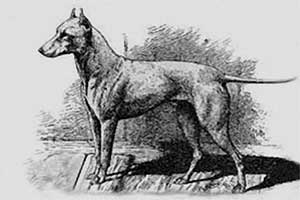 One of the most interesting, as well as most misrepresented extinct dogs in history, the English White Terrier is more famous for its contribution to the development of other breeds than for its own working qualities and recognition. It must be mentioned than most terrier breeds in old Britain had existed without proper distinction from one another for centuries, loosely separated into regional groups based on colour, coat type, overall size and area of origin. The white-coated terriers have been around since the late 17th century, but never as a separate breed as much as simply a coat variety of existing terrier populations in their respective regions. It was only in the second half of the 19th century that various names had been assigned to breeds of terriers by their fanciers in England, where Dog Shows gained immense popularity at the time. While quite a few white terriers were common in the United Kingdom, the most fascinating one is the breed named "English White Terrier", which was around for only a short period of time in comparison to its numerous relatives.
One of the most interesting, as well as most misrepresented extinct dogs in history, the English White Terrier is more famous for its contribution to the development of other breeds than for its own working qualities and recognition. It must be mentioned than most terrier breeds in old Britain had existed without proper distinction from one another for centuries, loosely separated into regional groups based on colour, coat type, overall size and area of origin. The white-coated terriers have been around since the late 17th century, but never as a separate breed as much as simply a coat variety of existing terrier populations in their respective regions. It was only in the second half of the 19th century that various names had been assigned to breeds of terriers by their fanciers in England, where Dog Shows gained immense popularity at the time. While quite a few white terriers were common in the United Kingdom, the most fascinating one is the breed named "English White Terrier", which was around for only a short period of time in comparison to its numerous relatives.
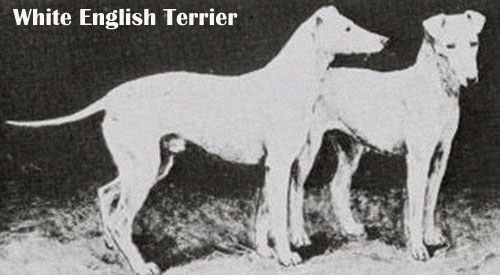 There are many theories regarding this near-mythical breed of dog and its true origin, some of which claim it to had been an albino version of the original Manchester Terrier, while others imply that it was an early incarnation of the English Bullterrier and even a miniaturized type of the old Alaunt. Dogs which fit the description of the White English Terrier have existed since the mid-1600's and are believed to had been developed by crossing various white-coated terriers with smaller greyhounds and bulldogges, but it wasn't until the 1860's that the strain was established as an actual breed, when the already existing White Terrier was enriched with the blood of the Whippet and local bull-n-terriers of Manchester and Birmingham. It is believed that the Whippet was used in the breeding programme to add elegance and speed, but this experiment had reportedly also robbed the White Terrier of its fighting spirit and stamina, so some early Foxterriers, Jack Russel Terriers and early working bull-n-terriers were added to the breed's genepool, reviving its physical strength, gameness and health. However, issues like sensitive skin and deafness continued to plague many White English Terriers and although this new version of the breed was still used for hunting foxes, exterminating vermin and dog fighting on occasion, it was its beauty which made it famous in England, where it enjoyed moderate popularity in Dog Shows in the late 1800's, before eventually becoming extinct in the early 20th century.
There are many theories regarding this near-mythical breed of dog and its true origin, some of which claim it to had been an albino version of the original Manchester Terrier, while others imply that it was an early incarnation of the English Bullterrier and even a miniaturized type of the old Alaunt. Dogs which fit the description of the White English Terrier have existed since the mid-1600's and are believed to had been developed by crossing various white-coated terriers with smaller greyhounds and bulldogges, but it wasn't until the 1860's that the strain was established as an actual breed, when the already existing White Terrier was enriched with the blood of the Whippet and local bull-n-terriers of Manchester and Birmingham. It is believed that the Whippet was used in the breeding programme to add elegance and speed, but this experiment had reportedly also robbed the White Terrier of its fighting spirit and stamina, so some early Foxterriers, Jack Russel Terriers and early working bull-n-terriers were added to the breed's genepool, reviving its physical strength, gameness and health. However, issues like sensitive skin and deafness continued to plague many White English Terriers and although this new version of the breed was still used for hunting foxes, exterminating vermin and dog fighting on occasion, it was its beauty which made it famous in England, where it enjoyed moderate popularity in Dog Shows in the late 1800's, before eventually becoming extinct in the early 20th century.
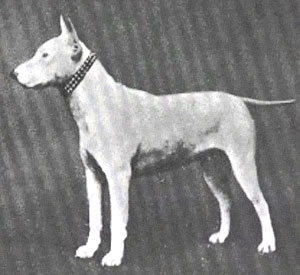 While the legendary White English may have been a short-lived and unsuccessful creation on its own, the influence it had on a great number of other breeds is nothing short of astonishing. The White English Terrier was highly prized for its gameness and tenacity, both in hunting and fighting, but also for its great intelligence which made it a superiour warrior, noted as being too quick, calculated and energetic for old bulldogges it was pitted against, inspiring many "sport" enthusiasts to use the breed as an outcross for their fighting lines of bull-baiting and dog-fighting dogs. It could be argued that it was its white colouring or its great intelligence or its superb gameness which were desired by the creators of these other breeds that they would use the White Terrier in their programmes, just as it could be assumed that many of those breeds were essentially a by-product of the many crosses made with goals of improving the English White by its fanciers. Whatever the case may had been, the White English Terrier was instrumental in the establishment of the English Bullterrier, American Pit Bull Terrier, English Staffordshire Bull Terrier, Yankee Terrier, Jack Russel Terrier, American Staffordshire Terrier, Foxterrier, Irish Staffordshire Bullterrier, American Bulldog, Dalmatian, Boston Terrier and many other breeds from around the world, including the great warrior dogs from India and Pakistan, where the Indian Bull Terr is considered by many fanciers to be not only a descendant of the old English White, but the very same breed which succesfully survived in India while it became extinct in the West.
While the legendary White English may have been a short-lived and unsuccessful creation on its own, the influence it had on a great number of other breeds is nothing short of astonishing. The White English Terrier was highly prized for its gameness and tenacity, both in hunting and fighting, but also for its great intelligence which made it a superiour warrior, noted as being too quick, calculated and energetic for old bulldogges it was pitted against, inspiring many "sport" enthusiasts to use the breed as an outcross for their fighting lines of bull-baiting and dog-fighting dogs. It could be argued that it was its white colouring or its great intelligence or its superb gameness which were desired by the creators of these other breeds that they would use the White Terrier in their programmes, just as it could be assumed that many of those breeds were essentially a by-product of the many crosses made with goals of improving the English White by its fanciers. Whatever the case may had been, the White English Terrier was instrumental in the establishment of the English Bullterrier, American Pit Bull Terrier, English Staffordshire Bull Terrier, Yankee Terrier, Jack Russel Terrier, American Staffordshire Terrier, Foxterrier, Irish Staffordshire Bullterrier, American Bulldog, Dalmatian, Boston Terrier and many other breeds from around the world, including the great warrior dogs from India and Pakistan, where the Indian Bull Terr is considered by many fanciers to be not only a descendant of the old English White, but the very same breed which succesfully survived in India while it became extinct in the West.
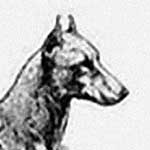
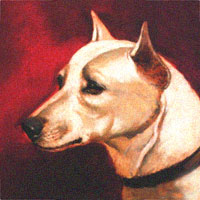 The English White Terrier came in a few varieties, separated by size, ear type and colouring, these variations being of little importance for working breeders, but those whose goal was to establish a Show dog wanted an uniform white coat, as opposed to the hunting and fighting types, which could have small dark markings on the head and body. After the ban on ear-cropping, the Show variety was maintaned as a naturally erect-eared dog, with gentler features, while the working variety could still be seen with drop ears and thicker bodies. This was a muscular and long-necked breed, courtesy of old Whippet influence, from which it also inherited great sight and speed. The head of the White English Terrier was somewhat narrow, wedge-shaped and with an almost flat skull, strong muzzle and tight lips. The eyes were relativelly small, always black or dark brown in colour. The preferred nose colour was black, although poorly pimented dogs existed as well, but weren't valued, due to the observed inferiourity in their temperament and health.
The English White Terrier came in a few varieties, separated by size, ear type and colouring, these variations being of little importance for working breeders, but those whose goal was to establish a Show dog wanted an uniform white coat, as opposed to the hunting and fighting types, which could have small dark markings on the head and body. After the ban on ear-cropping, the Show variety was maintaned as a naturally erect-eared dog, with gentler features, while the working variety could still be seen with drop ears and thicker bodies. This was a muscular and long-necked breed, courtesy of old Whippet influence, from which it also inherited great sight and speed. The head of the White English Terrier was somewhat narrow, wedge-shaped and with an almost flat skull, strong muzzle and tight lips. The eyes were relativelly small, always black or dark brown in colour. The preferred nose colour was black, although poorly pimented dogs existed as well, but weren't valued, due to the observed inferiourity in their temperament and health.
The coat was short, flat and glossy, without undercoat. Average height was around 20 inches, although smaller dogs existed as well.
